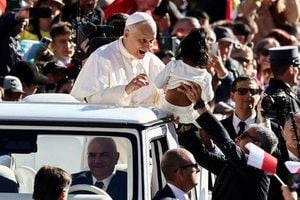On the morning of October 3, 2025, the world of journalism lost one of its own on the front lines of Ukraine. French photojournalist Antoni Lallican, a seasoned professional known for his dedication to covering conflict zones and human rights issues, was killed in a drone strike while accompanying Ukrainian military personnel in the Druzhkovka area. The attack, which has drawn international attention and sorrow, also left Ukrainian journalist Heorgiy Ivanchenko injured. Both journalists were clearly marked as press, wearing bulletproof vests emblazoned with the word “Press,” according to the International and European Federations of Journalists (IFJ-EFJ).
Lallican’s death was confirmed by French authorities, the Hans Lucas photo agency, and the International Federation of Journalists. He was either 37 or 38 years old at the time of his death (sources vary slightly on his age), but there’s no doubt about the legacy he leaves behind. Lallican had been with Hans Lucas since 2018, and his career was marked by a relentless pursuit of stories in some of the world’s most dangerous places. According to a statement from Hans Lucas, "His work focused on social and societal issues, with a particular focus on conflict zones and human rights." The agency further described him as "particularly committed to the conflict in Ukraine," noting that he had been traveling to the country regularly since Russia’s invasion began in February 2022.
The risks journalists face in war zones are never far from the minds of those who send them into harm’s way—or those who wait anxiously for their safe return. French President Emmanuel Macron, in a statement posted on X (formerly Twitter) in Ukrainian, expressed his condolences to Lallican’s family, loved ones, and colleagues. Macron’s words were tinged with grief and recognition of the sacrifices made by journalists: "I learned with deep sadness of his death, a victim of a Russian drone attack." He added, "I express my heartfelt condolences to his family, loved ones, and all his colleagues." Macron also acknowledged the broader dangers faced by reporters in conflict zones, stating that Lallican "was accompanying the Ukrainian army on the front of resistance."
The loss was felt not only in France but also in Ukraine and across the international journalism community. Ukraine’s Minister of Foreign Affairs, Andrii Sybiha, joined Macron in expressing his condolences to Lallican’s family and colleagues. The International Federation of Journalists, which confirmed the details of Lallican’s death, underscored the ongoing risks journalists face when reporting from active war zones. In this case, both Lallican and Ivanchenko were taking the standard precautions—wearing protective gear and clearly identifying themselves as members of the press—yet still became targets in the conflict.
For those who knew Lallican or followed his work, his death is both a personal tragedy and a stark reminder of the perils that come with bearing witness. The Hans Lucas photo agency recalled his significant contributions since joining the company in 2018. "Particularly committed to the conflict in Ukraine, he had been traveling there regularly since the start of the Russian invasion in February 2022," the agency stated in remarks to CNN. Lallican’s photography often shone a light on stories that might otherwise have gone untold—especially those involving social upheaval, human rights abuses, and the resilience of people in the face of adversity.
Lallican’s commitment to the Ukrainian conflict was evident in his repeated journeys to the country. Since Russia’s invasion, Ukraine has become one of the world’s most dangerous places for journalists, with the front lines constantly shifting and the threat of violence ever-present. Despite these dangers, Lallican returned again and again, determined to document the realities of war for the outside world. His work not only informed international audiences but also provided a crucial record of events as they unfolded.
The attack that claimed Lallican’s life took place in the Druzhkovka area, a region that has seen heavy fighting and repeated drone strikes since the escalation of hostilities. According to the International and European Federations of Journalists, the strike happened on the morning of October 3, 2025, as Lallican accompanied Ukrainian military personnel. The same attack injured Ukrainian journalist Heorgiy Ivanchenko, further highlighting the indiscriminate nature of the violence facing those covering the war. Both men were wearing bulletproof vests marked "Press," a detail that underscores the risks faced by journalists even when they take every possible precaution.
The international response to Lallican’s death has been swift and somber. Alongside President Macron’s public statement, the Hans Lucas agency’s tribute, and the condolences from Ukraine’s foreign minister, the broader journalism community has rallied to honor Lallican’s memory and call for greater protections for journalists in conflict zones. The International Federation of Journalists reiterated the importance of upholding the safety and rights of reporters, especially in areas where the lines between combatants and non-combatants are often blurred.
Lallican’s story is not unique, but it is deeply resonant. Journalists have long risked—and sometimes lost—their lives in pursuit of the truth, particularly in conflicts where information is as fiercely contested as territory. The dangers are manifold: drone strikes, artillery fire, sniper attacks, and the ever-present threat of abduction or detention. Yet, as Lallican’s career demonstrates, the commitment to telling these stories remains undiminished. His work in Ukraine, as well as in other conflict zones, stands as a testament to the courage and resilience of journalists everywhere.
The tragedy of Lallican’s death is compounded by the fact that he was not alone in his commitment. The attack that killed him also injured a fellow journalist, and countless others continue to put themselves in harm’s way to report on the realities of war. Their work is essential—not just for informing the public, but for holding those in power accountable and ensuring that the stories of those affected by conflict are not forgotten.
As the world grapples with the ongoing conflict in Ukraine and the broader challenges facing journalists in war zones, Lallican’s legacy serves as both a warning and an inspiration. His dedication to his craft, his willingness to return to dangerous places, and his focus on stories that matter—all of these qualities are reminders of the vital role that journalists play in our understanding of the world.
Antoni Lallican’s death is a loss for his family, his colleagues, and the global community of reporters who continue to risk their lives for the truth. But his work endures, a powerful record of resilience and resistance in the face of overwhelming odds.




